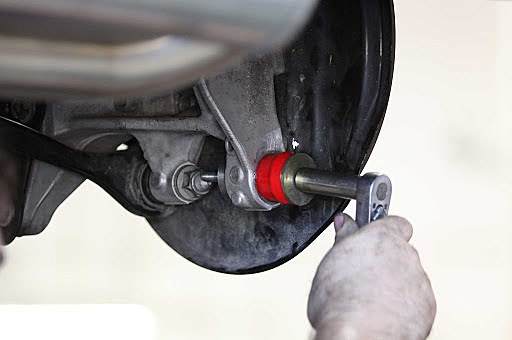A Beginner’s Guide: Improving Handling

(Photo Credit: Autoexpress)
Your car’s handling is a key point in your driving experience. How your car traverses the road is not only important to how fast you can go, but the better it handles, the safer it will also be.
Picture this, you’ve had your car for a while now and you’ve become used to how it handles. You know what to expect when turning or under spirited acceleration or braking. Now you crave a little more, you want it to turn in a little sharper, maybe you want less body roll, or maybe the wheels are spinning a little too much for your liking. Don’t worry because here are some things you can do to your car to improve its handling.
Tyres

(Photo Credit: Autocar)
This is the single most important and influential part of how your car handles as the tyres are the only parts of your car that are in contact with the road. No matter how much power or handling mods you might have, if you’ve got rubbish tyres, you still won’t go any faster.
Changing to a set of performance-oriented street tyres will transform the way your car handles. While different tyres have different characteristic, in general, better tyres means more grip and everyone loves more grip. With more grip, not only will your car be able to carry more speed through corners, it’ll also reduce braking distances, and reducing wheelspin will improve acceleration.
Performance tyres also usually come with a stiffer sidewall than in your eco tyre, this means that under heavy load, the tyre’s sidewall will not flex as much which means you’ll be able to keep more of the tyre in contact with the road at all times.
Do take note however, that the more performance-oriented your tyres are, the more aggressive the compound or tread pattern might be, which may mean much less grip in the wet as compared to a more street-oriented or all-rounded tyre.
Suspension

(Photo Credit: Winn Autosport)
The next mod to improve handling is a good set of suspension. You have the option of a new OEM set if your old suspension components are getting a bit worn out. While this may not improve your handling by a huge margin, if your previous set was getting a little worse for wear, new OEM suspension is a safe and usually cheaper option of bringing your car back to the condition it was when it left the factory.
The other option is a set of aftermarket coilovers. These kits usually come ready to be installed with springs, dampers, and all the hardware required to put it on. Aftermarket coilovers are available for how ever large your budget is, with more expensive sets usually allowing more adjustability than cheaper ones.
A decent set of coilovers will usually come with adjustment for the dampening of the shock, and a much stiffer spring rate than your stock suspension. What this means is your suspension is not as easily compressed as your stock set, which translates into less body roll and weight transfer. That then translates into more direct steering and sustained grip through corners. Coilovers also allow you to lower your ride height which in turn will lower your car’s centre-of-gravity which means better stability through turns.
A common misconception however is that the stiffer your suspension is, the more grip you have. This is where dampening, compression, and rebound come into play. These elements of suspension could have an article all of their own but the basic concept is this; you want your suspension stiff enough to reduce body roll but not stiff to the point where it’s not able to be compressed at all, as you need some movement in the suspension to generate grip. A rock hard suspension setup also means that your car will destabilise over bumps in the road, not to mention being incredibly uncomfortable to drive.
Wheel Alignment and Tyre Pressures

(Photo Credit: iStock)
A set of coilovers will also allow you more flexibility in adjusting your car’s alignment through variables such as toe, camber, and caster. These factors could also warrant an entire article of their own (which we’ll get into soon), as they hugely influence how your vehicle handles. The premise of a proper alignment setup is to ensure that your tyres are as much in contact with the road as possible without causing excessive tyre wear or instability.
Like everything else to do with the way your tyres touch the road, your tyre pressures also impact how your car handles. Lower pressures mean the tyre has a larger contact patch with the road, while this generally means more grip, too low a pressure also means that your rolling resistance is greatly increased which results in a lower top speed and higher fuel consumption. Lower tyre pressures also mean that you’ll take a little longer to get heat into your tyres, which if you’re on a set of performance tyres may mean you won’t get the optimal grip from your tyres. Low tyre pressures also mean your car’s response on turn in is reduced.
However, raising your tyre pressures may result in temperature building too quickly and overheating the tyre during your run. High pressures may mean better response but due to the reduced contact patch, your car might get a little skittish if the pressures are too high.
Strut Bars and Body Braces

(Photo Credit: Team-BHP)
These are usually bolt-on aftermarket items that you can add to your car to improve your car’s rigidity by reducing the amount of flex between the various components on your car. As the name suggests, strut bars usually attach to the top or bottom of your suspension struts to reduce flex, you might often see them in an engine bay connecting the two suspension top hats. Other underbody braces are also available depending on your car to stiffen up the underbody and reduce chassis flex, all this is meant to reduce how much your car itself flexes under load, allowing you to take corners flatter.
Weight Reduction

(Photo Credit: Driver61)
Weight is a huge part of how your car handles because of simple physics, more weight means more mass that has to be moved around which requires more force to overcome inertia. More weight also means more drastic weight transfer which also affects how your car handles. By reducing weight, you reduce the amount of inertia that has to be overcome, what this means is your car will be able to accelerate faster, change direction quicker, and brake in less distance than a heavier car.
Why do you think F1 cars try to shave off as much weight as physically possible? It’s all in the name of going faster because weight reduction is essentially free speed. Shaving off the kilos also means better fuel consumption, less tyre wear, and less load on the brakes and engine as they have to do less work.
Weight reduction comes in literally all forms. You can start removing unnecessary items from your car such as a spare tyre or all the other junk you’ve hoarded inside (you know who you are). There are lighter aftermarket items available for pretty much every single part on your car such as wheels, seats, steering wheels, dashboards, body panels, windows etc. the list just goes on. If you have the budget and the commitment to this vehicular diet, you can replace everything with lightened parts to chase that lower weight figure. If you’re feeling hardcore, you can also remove additional seats or strip out the interior to be extra ready for your next track day.
Polyurethane Bushes
(Photo Credit: Superstreetonline)
A lot of your components on your car’s body are cushioned in their joints by bushes/bushings. These come made of rubber from the factory as it’s cheap to produce and provides additional comfort for the occupants. However, these rubber bushes tend to wear out and can almost disintegrate over time and extended use which means your ride and your alignment may become a little out of whack.
A popular upgrade option is to replace these rubber bushes with ones made of polyurethane. On top of being more durable, poly bushes don’t compress as much as rubber ones which means your car’s carefully tuned alignment is more likely to stay true for longer, and these bushes last damn near forever too. While there is a trade-off of a slightly rougher ride due to less cushioning, the relatively cheap performance and maintenance gains make them worth it in our book. Consider changing to poly bushes when it comes time to replace your rubber ones so you only have to make the change once.
When it comes to improving how your car handles and drives, the sky is the limit (that and your wallet), and you can really get crazy with how much you want to chase those gains. However, the upgrades listed here are the basics you can use to get started on improving your car’s handling.
Schedule a free COE renewal consultation session!
Read More: 7 Things That Will Damage Your Paint Job
Download the new Motorist App now. Designed by drivers for drivers, this all-in-one app lets you receive the latest traffic updates, gives you access to live traffic cameras, and helps you manage LTA and vehicle matters.
Did you know we have a Motorist Telegram Channel? Created exclusively for drivers and car owners in Singapore, you can get instant info about our latest promotions, articles, tips & hacks, or simply chat with the Motorist Team and fellow drivers.


